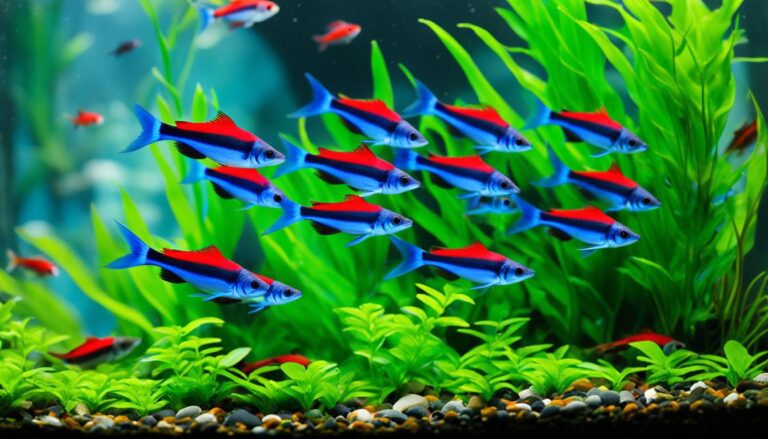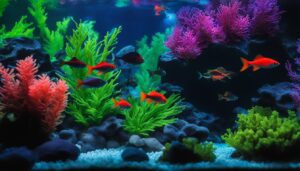I’ve learned a lot about Neon Tetras as an aquarist. These freshwater aquarium fish from the Amazon Basin are like jewels. They’re popular for their bright colors and calm nature. Every aquarium owner should know how to care for them.
When you add Neon Tetras to your tank, you’re helping keep biodiversity alive. They grow to about 1.5 inches and can live for up to 5 years if you care for them right. Their ideal water is warm, between 70°F and 81°F, soft, and slightly acidic.
Neon Tetras like having friends. A group of at least 6 is good, but more is even better. It makes them feel at home. Choosing calm tank mates, like gouramis and small catfish, is key.
A good diet, regular meals, and preventing diseases are crucial. This care lets our Neon Tetras live their best lives. It also lets us enjoy watching their peaceful swimming every day.
Neon Tetra Origins & Habitat

The neon tetra is a colorful fish from the Amazon Basin. It shows the area’s vast biodiversity. The health of their environment is crucial for their survival.
The Natural Habitat and Conservative Measures
Neon tetras live in the Amazon Basin’s blackwater and clearwater streams. They like areas with lots of plants and not much light. Deforestation is threatening their home.
We need to use land wisely and make laws to protect these fish. It’s important for keeping the water right for them to live.
The Impact of Environment on Neon Tetra Species
Changes in the environment hurt neon tetras. Deforestation and pollution change the water, which can make them sick. The conservation work in places like the Rio Negro is crucial.
We must teach people and control tourism to protect the Amazon’s waters. This helps keep neon tetras and many other species safe.
Species Name |
Habitat Description |
Conservation Status |
|---|---|---|
Neon Tetra |
Blackwater streams, heavily vegetated, low-light |
Stable, with ongoing conservation efforts |
Sailfin Characin |
Streams across the Amazon, diverse aquatic flora |
Under study, potentially at risk |
Tucano Tetra |
Acidic streams, dense forest cover, submerged woods |
Vulnerable due to habitat specificity |
It’s not just about saving one fish like the neon tetra. It’s about protecting the ecosystems that are key to our planet’s diversity. Every animal, including the neon tetra, has a role in keeping their home balanced. We need to protect them.
Neon Tetra Identification
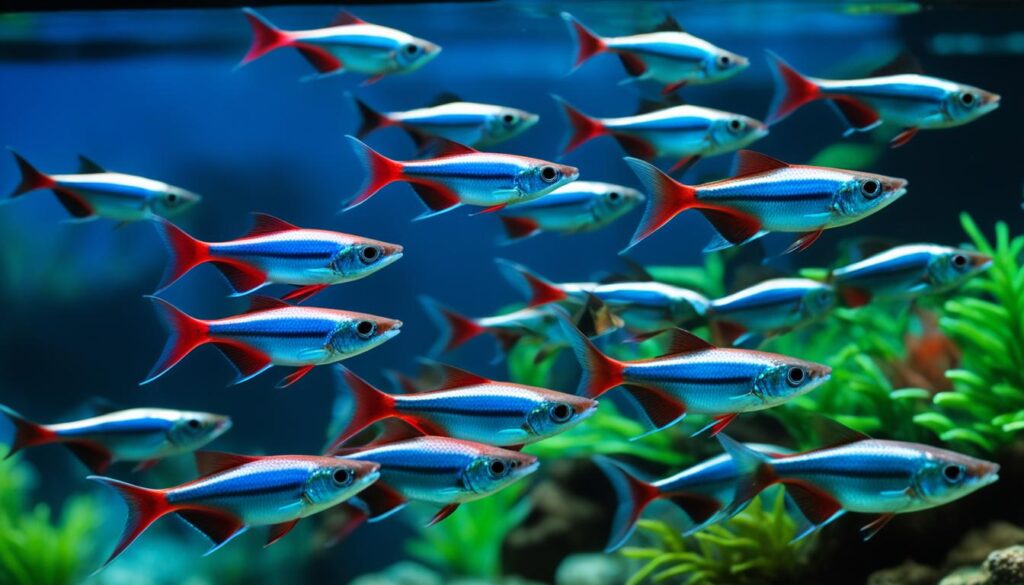
The neon tetra stands out in the world of aquarium fish. It’s known for its neon tetra features and vibrant colors. These small, torpedo-shaped fish have radiant blue and red stripes. They add dynamic color and life to any tank. It’s important to know the key traits for neon tetra identification.
The neon tetra’s bright blue stripe runs from its eye to its adipose fin. It contrasts with the iridescent red that starts halfway down its body and goes to the tail base. This stunning coloration catches the eye. It also helps them hide in the shaded, green waters of South America.
Neon tetras are tiny, measuring 2 to 3.8 cm, but their colors make them highly sought after by aquarium enthusiasts. They like water temperatures between 22 to 26°C. Soft, acidic water is their preference. This shows how vital it is to mimic their natural habitat in tanks.
Understanding their schooling nature enhances appreciation for these fish. Neon tetras are healthiest and most vibrant in groups of six or more. Their group movements and colors are a sight to behold.
Recognizing these traits is not just about their beauty. It’s essential for their health and vitality in aquariums. Knowing what a healthy neon tetra looks like helps spot diseases early. One such is Neon Tetra Disease, which causes fading colors and odd swimming.
Without a doubt, the neon tetra is a treasure in the aquarium world. Its beautiful look and social ways make it a favorite among both new and experienced fish keepers.
Neon Tetra Size and Lifespan in Captivity
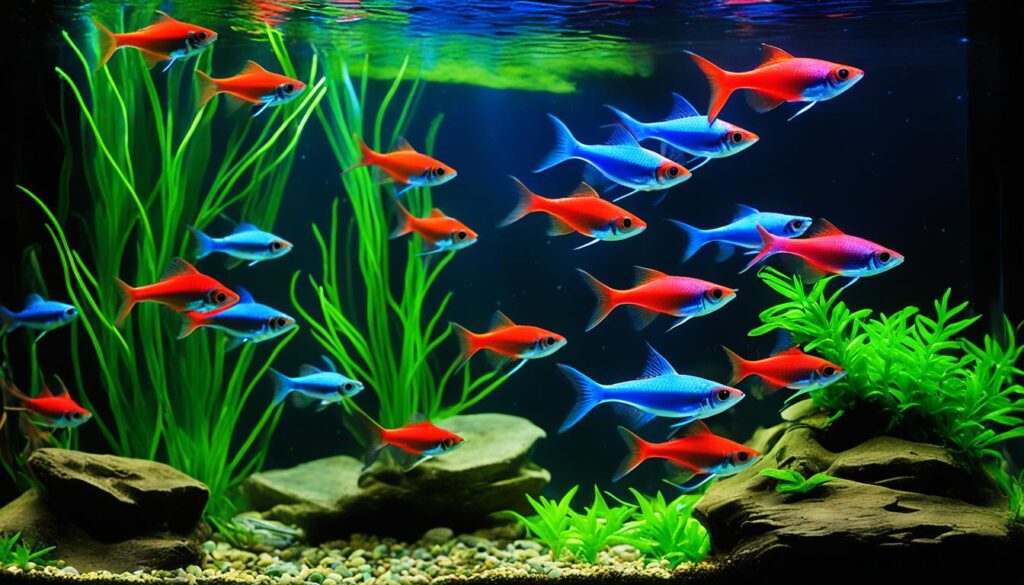
Neon tetras are loved by aquarium fans for their bright colors and small size. It’s key to know the differences in neon tetra sizes and neon tetra life expectancy between wild settings and aquariums. These factors change how they grow and how long they live, showing us the best ways to care for them.
Natural vs. Aquarium: A Comparison of Lifespan
In the wild Amazon, neon tetras can grow to 2.5 inches and live up to ten years. But, in tanks, they’re usually smaller, about 1.5 inches, and live for just 4-5 years. This shows how being in an aquarium affects their size and lifespan.
Sexual Dimorphism in Neon Tetras: Males vs. Females
Knowing about sexual dimorphism is important for taking care of neon tetras. Males look different from females, being thinner and having brighter and longer fins. This knowledge helps with breeding and gives better care for these fish.
Here’s a table that shows how to care for neon tetras in a tank:
Feature |
Wild Characteristics |
Captive Characteristics |
|---|---|---|
Size |
Up to 2.5 inches |
Approximately 1.5 inches |
Lifespan |
Up to 10 years |
4-5 years |
Group Size |
8-12 or more |
At least 6 |
Water Conditions |
pH 6.0-7.0, Temperature 72-76°F |
pH 6.0-7.0, Temperature 72-76°F |
By focusing on their needs and captive breeding, aquarium lovers can make their neon tetras healthier and brighter. Making their tanks like their natural home and noticing each tetra’s unique traits can help them live longer, better lives.
Neon Tetra Colors and Markings
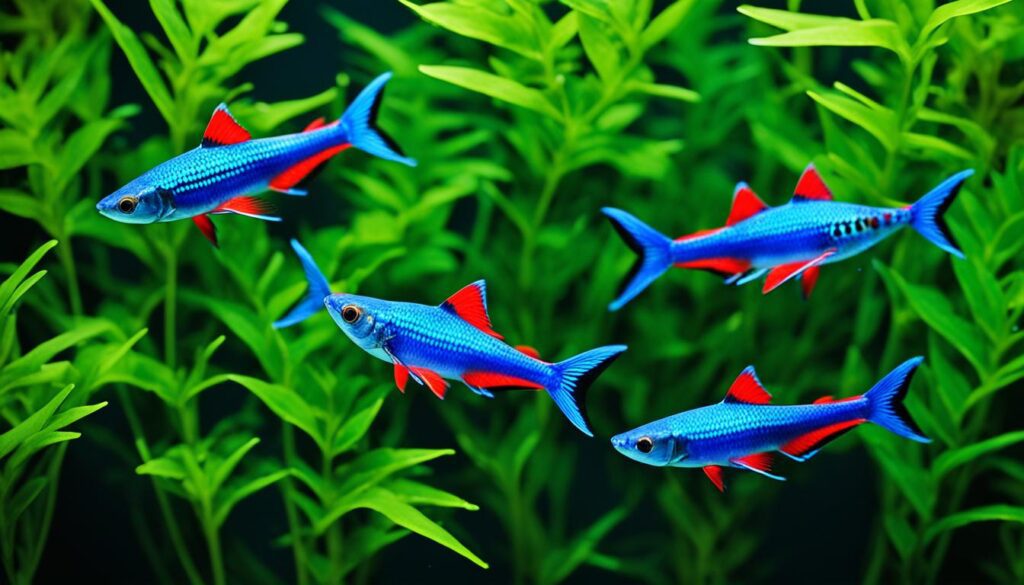
I’ve been drawn into the world of neon tetra colors and markings as a writer. These vibrant patterns captivate folks all over, not just for their aquarium fish beauty. They also thrill us with their complexity and brilliance. Let’s take a closer look at what makes these creatures so special.
Neon tetras brighten any tank with their metallic blue backs and neon red stripes. Under tank lights, their blue glows almost like lightning, matching the intense red that runs from their middle to their tail. This eye-catching look is more than just beauty. It’s a trick to keep predators away and helps them stick together with their buddies.
But their colors do more than just help them survive. They show how well these fish have suited up for life in both the Amazon River and our tanks. Their bold colors turn them into stars in home aquariums, adding a lot to ‘aquarium fish beauty’. Their colorful look makes us appreciate nature more, pushing us to aim for the perfect tank view.
Color |
Description |
Function |
|---|---|---|
Metallic Blue |
A shimmering bright blue covering the head and back |
Captures light, enhancing visibility in deep waters and facilitating schooling |
Neon Red |
Bright red stripe running from the middle of the body to the tail |
Used for recognition among species and evasion from predators |
Translucent Belly |
Clear, almost invisible underbelly |
Adds a level of subtlety to their vivid appearance, balancing the brighter tones |
Neon tetras are more than just a pretty sight. Their colors and patterns add a lot of life to any tank they’re in. Having them helps us dive into a colorful natural world right in our homes. They show us the amazing beauty we can bring into our lives with the right fish and care.
Social Behaviors of Neon Tetras

For anyone with an aquarium, it’s important to know about neon tetra schooling. Neon tetras tend to gather in groups. This not only makes them feel safe but also makes their social life better. The way these fish stick together is not just about staying alive. It also shows how social they can be, which is a delight to see.
The Importance of Group Size for Neon Tetra Wellbeing
When it comes to neon tetras, having friends around matters a lot. Studies have found that being in a big group keeps them healthy and happy. Keeping at least nine neon tetras together makes them feel at home. This lowers stress and lets them act more naturally.
Interactions Among Neon Tetras and Their Peers
The way neon tetras interact in a group – and with other fish – is key. They are peaceful and get along with friendly fishes. This creates a lively and balanced tank, just like their natural home.
Now, let’s look at some facts about the benefits of proper group sizes for neon tetras:
Benefit |
Description |
|---|---|
Reduction in Stress |
Neon tetras in adequate schools show significantly lower stress and anxiety levels. |
Communication Efficiency |
Larger schools enhance the ability to communicate about threats and food, fostering a robust social structure. |
Health and Longevity |
Appropriate numbers in schools correlate with better health and potentially longer lives due to stabilized social hierarchies. |
Behavioral Richness |
Proper schooling enables neon tetras to display natural behaviors more vividly, increasing overall aquarium enjoyment. |
Understanding neon tetras’ need for schooling helps them and us. It keeps them well and makes our aquariums more lively. It’s important for all aquarists to support their schooling nature. This leads to a healthier and more interesting tank.
Ideal Neon Tetra Tank Setup
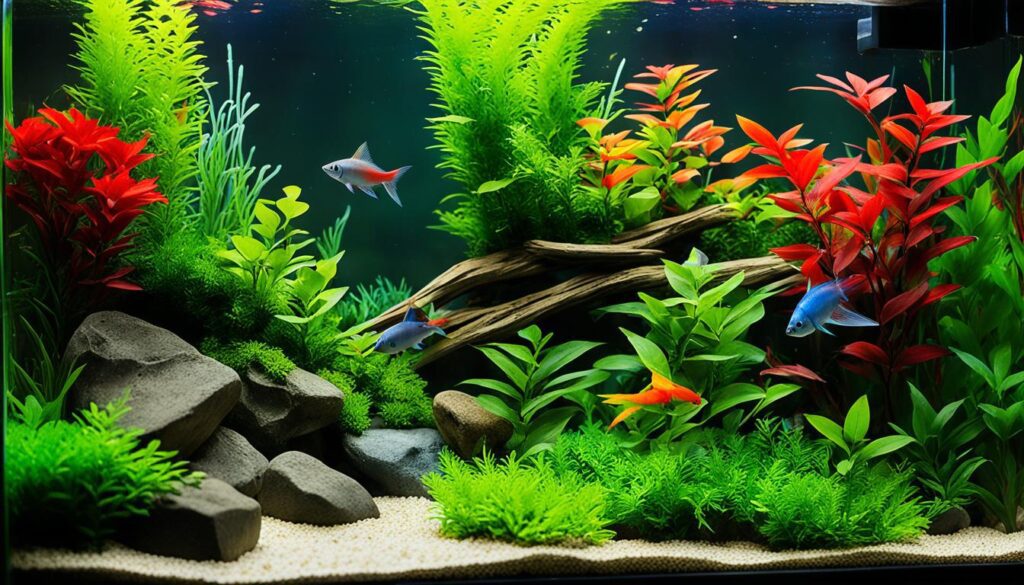
Creating the perfect home for neon tetras is very important. A great tank setup helps them stay healthy and happy. It also brings out their natural beauty, turning your aquarium into a breathtaking scene.
Recommended Tank Size and Decorations
First off, the size of the tank matters a lot. For neon tetras, start with at least a 10-gallon tank. A 20-gallon tank is better, especially for a group. Neon tetras love to swim in groups and need space. Adding decorations like rocks, driftwood, and soft lights makes them feel at home.
Strategizing Plant Placement and Tank Conditions
Plant placement is more than just for looks; it makes your fish feel safe. Plants like Java Fern, Amazon Sword Plant and Anubias are great. They also add oxygen to the water. Keeping the water clean and at the right pH is crucial for their health.
Here’s a handy guide for setting up your tank:
Tank Size |
Number of Neon Tetras |
Recommended Plants |
|---|---|---|
10 gallons |
6-8 |
Java Moss, Java Fern |
15 gallons |
Up to 10 |
Anubias, Water Wisteria |
20+ gallons |
10+ |
Amazon Sword, Hornwort |
Remember, your goal is to make the tank like their natural habitat. With the right setup and conditions, your neon tetras will be healthy and vibrant.
Neon Tetra Water Requirements

It’s key to know the right water requirements for a neon tetra tank. These lively fish need specific water conditions. They do best in soft, slightly acidic water like their home in the Amazon. The best water pH is between 6 and 7. They also like water hardness under 10 dGH. These are important for keeping your tank right.
Good tank maintenance means checking and tweaking water settings to keep things stable for neon tetras. You should keep the water temperature between 20–26 degrees Celsius. This helps them stay healthy. Also, a good filter system is a must. A sponge filter works great without making the water flow too strong.
Changing the water regularly is key to taking care of the water conditions. Changing 25-50% of the water every two weeks is a good rule. This lowers the chance of diseases by keeping nitrate and phosphate levels down. Also, make sure there is no ammonia or nitrite in the water to avoid harming the fish.
Understanding everything about a neon tetra’s needs helps you take better care of them. This makes your neon tetra tank a lively and healthy place for these small, colorful fish.
Feeding Neon Tetras
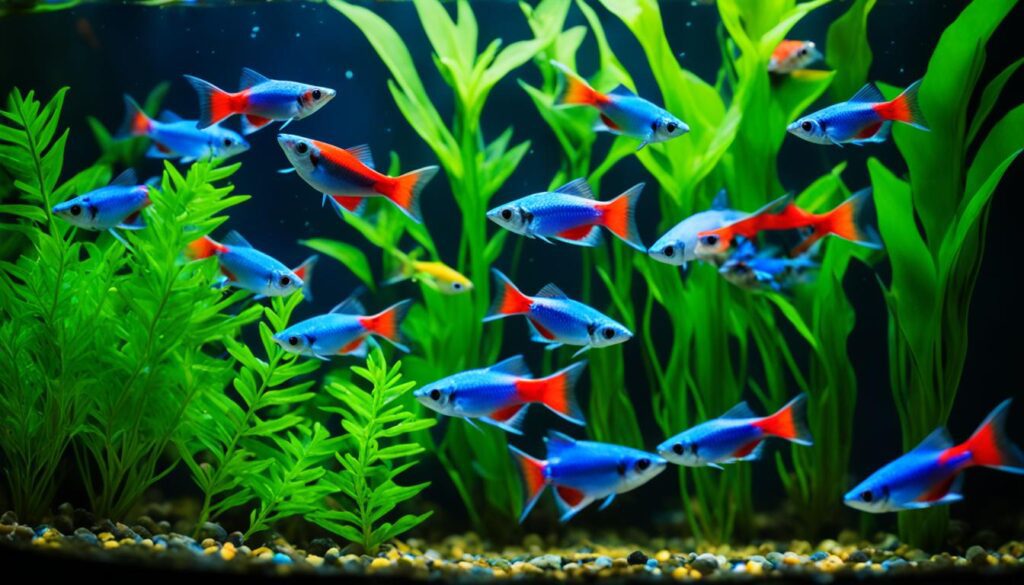
It’s important to know what neon tetras need to eat and when to feed them. This keeps them healthy and happy. These fish are a top choice for many who love aquariums. They eat lots of different foods because they are omnivores.
Cultivating a Nutrient-Rich Diet for Neon Tetras
Feeding neon tetras right means giving them a mix of foods. Start with high-quality flake food for their daily meals. Then, add frozen or live foods like bloodworms and brine shrimp. This mix is closer to what they eat in the wild. You can also give them blanched vegetables, such as zucchini, now and then.
Neon tetras are small, so they eat tiny amounts. Be careful not to feed them too much. They should finish eating in about three minutes. Give them a little food, no more than a teaspoon tip’s worth, two times a day.
Avoiding Overfeeding: Best Practices
Avoiding overfeeding keeps the water clean and the fish healthy. Feed your neon tetras twice a day. Give them only as much as they can eat in three minutes. You might feed them less as they get older, maybe once a day.
Watch your fish when you feed them. It tells you how healthy they are. Healthy neon tetras are quick to eat, look bright, and swim actively. If they seem slow or not interested in food, they might be overfed or not eating the right foods.
Proper feeding and watching how your neon tetras eat and act helps them do well. They will show their best colors and be active swimmers.
Neon Tetra Compatibility & Tank Mates
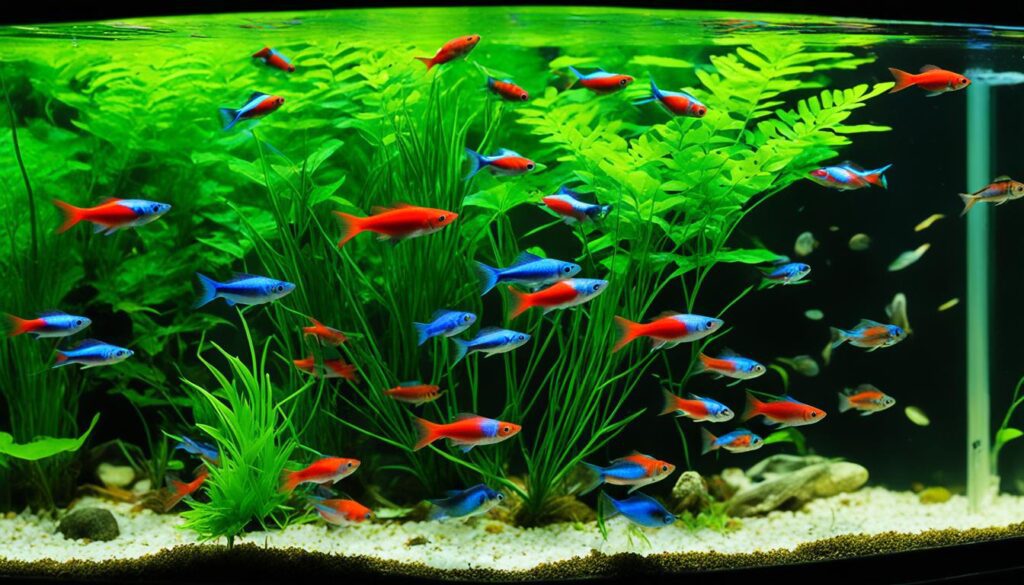
Finding the right tank mates for neon tetra is crucial for a happy tank. These colorful fish do well with other peaceful, similar-sized species. Together, they create a balanced and beautiful environment.
Companionable Species for Neon Tetras
Neon tetras are small, reaching only 1-2 inches in length. They thrive with fish that are peaceful and the same size. Good choices for tank mates are:
- Harlequin Rasboras – They enjoy the same soft, slightly acidic water as neon tetras.
- Corydoras Catfish – These friendly fish keep the tank’s bottom clean.
- Guppies – Known for their bright colors and calm nature, they’re great companions.
- Dwarf Gouramis – Just have one male per tank to avoid fights.
These fish not only need similar conditions but also add life and color to your tank.
Cautions when Selecting Fish to Share Their Environment
Some fish can’t live with neon tetras. Avoid predatory or much larger fish as they can stress or harm neon tetras. Also, fish needing very different water conditions may not fit well.
Make a list of possible tank mates and research them. This helps avoid problems and keeps your neon tetras happy and safe.
When setting up your tank, think about the needs and nature of each fish. The goal is not just a pretty tank, but a healthy, calm home for everyone. This approach ensures real harmony in your aquarium.
Breeding Tips and Techniques
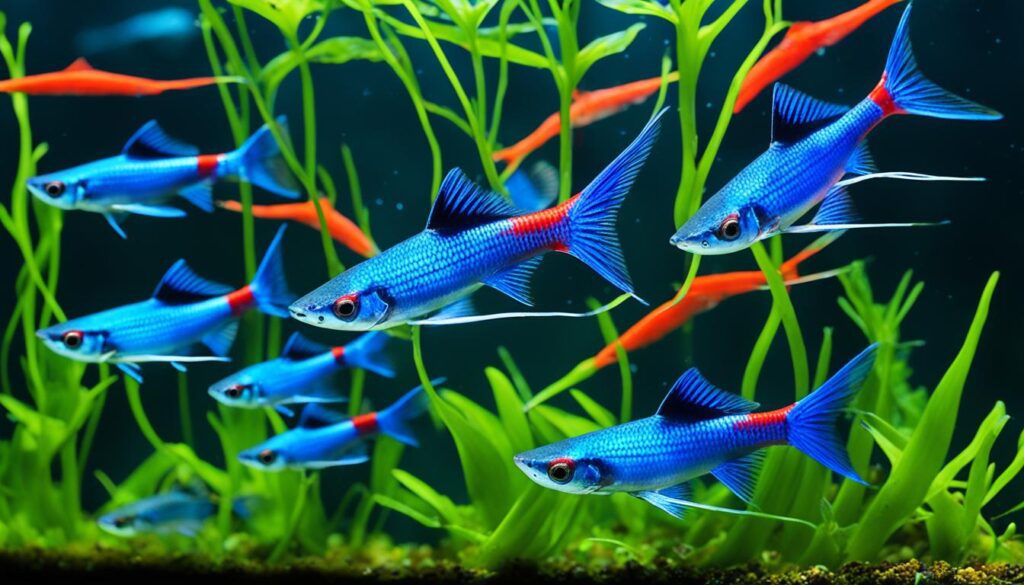
Breeding neon tetras is both fascinating and complex. It’s crucial to know how to manage neon tetra spawning and create the best aquarium reproduction environment. I’m here to share valuable insights and practices from experienced breeders to help you master this exciting part of fish breeding tactics.
Start with setting up a special breeding tank. Neon tetras need a specific environment for spawning. This tank should be about 10 gallons. It should mimic their natural conditions which are soft and acidic. Adding peat to the filter or using blackwater extracts can help get the right water conditions. Check out this guide for more setup tips.
Condition |
Recommendation |
|---|---|
Tank Size |
10 gallons |
Water Type |
Soft, acidic |
Additional Requirements |
Peat in filter, blackwater extracts |
Knowing how neon tetras spawn is key. They scatter eggs and don’t care for them. So, you must remove the adults after spawning to protect the eggs. Use a spawning mat or java moss to collect eggs safely. Keeping the water clean and at the right temperature is vital. The temperature should stay between 72-78°F for the best breeding conditions.
Feeding your neon tetras right is also crucial. Give them quality live foods like brine shrimp or micro worms. This helps them be ready to reproduce. Stick to a regular feeding schedule and keep the tank clean. This way, you’ll have a better chance of successful breeding.
Be patient. Neon tetras might not spawn right away. Finding the right conditions can take time. Keep an eye on things and make necessary adjustments. With careful attention and persistence, you’ll get to see neon tetra fry begin their life in your tank.
Breeding neon tetras is rewarding. It lets you see life grow and teaches you more about these colorful fish. Remember, each aquarium and tetra pair is different. What works for one set might not work for another. Keep learning and adapting. That’s how you’ll succeed in neon tetra breeding.
Prevention and Treatment of Common Diseases
As an aquarist, keeping my aquatic pets healthy is my top priority. Neon tetra care is very important, especially in preventing and treating diseases. They are strong fish but can still get sick from diseases like Neon Tetra Disease (NTD). Watching closely for signs of sickness such as restlessness, color loss, and odd swimming is crucial. If your fish start acting odd or lose their color, you need to act fast.
Preventing disease starts with a good environment and food. Clean water and the right diet can really protect your neon tetras. For example, to avoid Neon Tetra Disease, don’t use contaminated live food and keep the tank clean. This disease comes from a parasite that fish get from eating infected stuff. So, clean water and safe food are very important. Also, putting new fish in quarantine can help keep your tank healthy.
If diseases do appear, quick treatment is needed. There’s no cure-all for diseases like NTD. You must isolate and remove sick fish to stop the disease from spreading. Keeping the tank clean and full of oxygen helps sick fish get stronger. Even though clean water usually prevents disease, if your fish do get sick, providing a safe place for them to recover is important. Sometimes, fish may need medicine baths or other treatments from a vet.
The key for neon tetra owners is to always be watchful and aim for the best care. With the right knowledge and preventive steps, you can have a healthy and bright fish tank. Your neon tetras will be able to swim happily.
